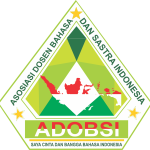MAKNA TEKSTUAL DAN INTERPERSONAL PIDATO BILL GATES: UNIVERSITAS HARVARD (2007) MENURUT TEORI METADISCOURSE HYLAND
Abstract
This study aims to analyze the interpersonal and textual meanings conveyed by Bill Gates at the graduation of Harvard University students in 2007 by using the metadiscourse theory introduced by Hyland. By analyzing the interactional and interactive sources found in the speech, the interpersonal and textual meanings can be revealed. The data were collected and selected from the text of Bill Gates' speech at the graduation of Harvard university students in 2007 which was retrieved from news.harvard.edu. The steps of analyzing data include describing the elements of linguistic data, calculating the percentage of interactive and interactional sources found in the speech, then analyzing the data to reveal the interpersonal and textual meanings. The results show that there are 74.6% interactive resources and 25.4% interactional resources found in Bill Gates' speech. Among these resources, the transitions of interactive resources are in the first place with a percentage of 63,7%. It indicates that Bill Gates was very good at organizing texts, making text clear and coherent for his audience, so that it became easier for them to find connections between arguments and better understand about what he was saying.
Keywords
Full Text:
PDFReferences
Aimah, S., Mulyadi, D., & Ifadah, M. (2019). Metadiscourse markers written in introduction section of final project of Unimus EFL learners. English Review: Journal of English Education, 7(2), 109–118.
Amiryousefi, M., & Rasekh, A. E. (2010). Metadiscourse: definitions, issues and its implications for English teachers. English Language Teaching, 3(4), 159–167.
Bax, S., Nakatsuhara, F., & Waller, D. (2019). Researching L2 writers’ use of metadiscourse markers at intermediate and advanced levels. System, 83, 79–95.
Bayyan Sr, A. F. (2016). One-to-one mobile technology and standardized testing: A quantitative ex post facto study. University of Phoenix.
Cao, F., & Hu, G. (2014). Interactive metadiscourse in research articles: A comparative study of paradigmatic and disciplinary influences. Journal of Pragmatics, 66, 15–31.
Haikal, H. (2018). Interactive metadiscourse and interactional metadiscourse categories of students’international program school based on gender. IJEE (Indonesian Journal of English Education), 5(1).
Halliday, M. A. K. (1994). An introduction to functional grammar (2nd edn). London and Melbourne: Edward Arnold.
Hyland, K. (2001). Humble servants of the discipline? Self-mention in research articles. English for Specific Purposes, 20(3), 207–226.
Hyland, K. (2005). Stance and engagement: A model of interaction in academic discourse. Discourse Studies, 7(2), 173–192.
Hyland, K. (2018). Metadiscourse: Exploring interaction in writing. Bloomsbury Publishing.
Hyland, K., & Tse, P. (2004). Metadiscourse in academic writing: A reappraisal. Applied Linguistics, 25(2), 156–177.
Mazidah, E. N. (2019). A Comparison of the Interactive Metadiscourse in the Abstracts of Articles Written by Indonesian And NES Scholars. ETNOLINGUAL, 3(1).
Pooresfahani, A. F., Khajavy, G. H., & Vahidnia, F. (2012). A contrastive study of metadiscourse elements in research articles written by Iranian applied linguistics and engineering writers in English. English Linguistics Research, 1(1), 88–96.
Remarks of Bill Gates, Harvard Commencement 2007. (2007). The Harvard Gazette. https://news.harvard.edu/gazette/story/2007/06/remarks-of-bill-gates-harvard-commencement-2007/
Strother, R. (2007). Bill Gates: Microsoft Founder: Microsoft Founder. ABDO.
Suryana, & Riduwan. (2010). Metodologi penelitian: model praktisi penelitian kuantitatif dan kualitatif. Universitas Pendidikan Indonesia.
Toumi, N. (2009). A model for the investigation of reflexive metadiscourse in research articles. Language Studies Working Papers, 1, 64–73.
Wilson, S. R., & Sabee, C. M. (2003). Explicating communicative competence as a theoretical term.
Refbacks
- There are currently no refbacks.






